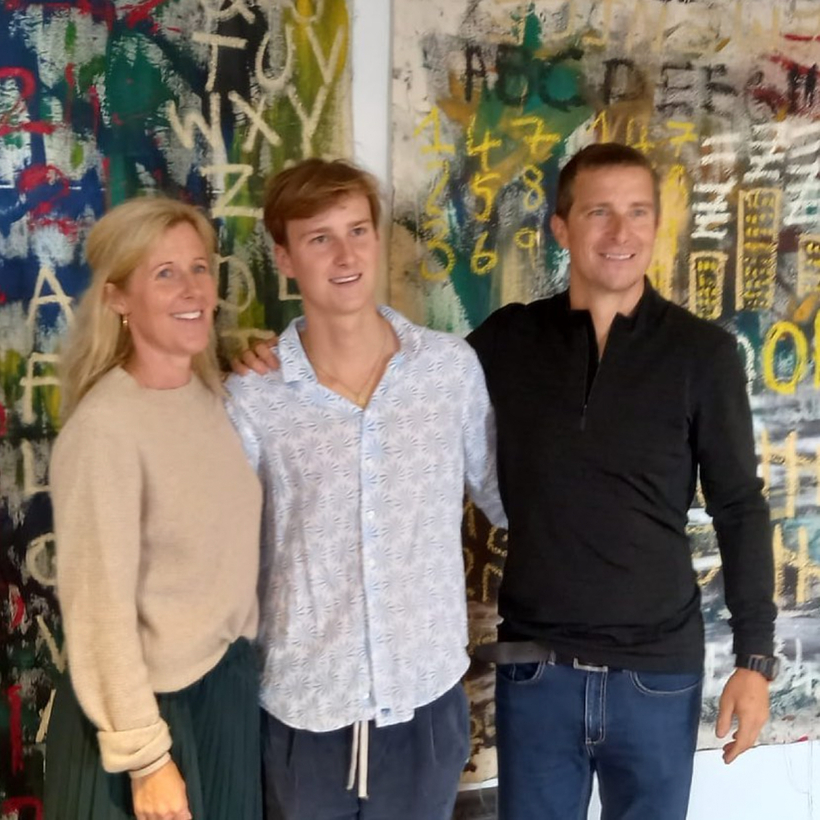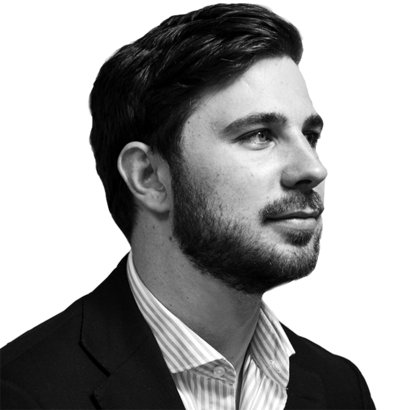In a national lockdown, you can either climb the walls or you can paint them. Jesse Grylls—the 18-year-old artist whose first exhibition makes a brief but punchy cameo at London’s Battersea Power Station this month—decided to get out the brushes. (And the spray paint, and the acrylics, and the sackcloth, and the oils.)
Over a fervid two years, the young painter—holed up at home, unable to go to school—worked on hundreds, possibly thousands, of canvases, daubing them with endlessly repeating letters and shapes, and mad flecks of automatic writing, and half-remembered poems. (Eton, his recent alma mater, had to ship him batches of supplies just to keep things moving.) “I was by myself, every day, painting hundreds of pictures,” Jesse says. “And I kind of gained confidence to be able to paint whatever I wanted.”

Some of this energy is youthful. But a good chunk, one suspects, is genetic. Jesse is the eldest son of the adventurer, chief scout, and broadcaster Bear Grylls, whose irrepressible drive and enthusiasm are infectious enough through the screen—and must be near pathogenic in childhood. A trot up Everest here. A jaunt across the Northwest Passage there.
“I kind of gained confidence to be able to paint whatever I wanted.”
Fittingly, Jesse’s recent output seems like a test of endurance in itself. “Yeah, I got in a good flow,” he laughs, with gentle understatement. “It’s been two years nonstop, painting every day. It’s been intense. I need to take a break!” When the exhibition is over, he tells me, he’ll go traveling for a few months, after which he hopes to study fine art in Milan.
“All of my works are about the idea of finding freedom within structure, and that balance of chaos and regimentation,” he explains, standing in front of a splattered, nigh-on-luminescent canvas, marked with a repeated, shifting W motif. “Because I’m not thinking about the letter I’m doing, because I know how to do it with my eyes closed, it allows for a lot more expression or manipulation of how the letter looks—a result of whatever emotion I’m feeling.”

As we stand in the gallery space—a large, bare, industrial-style apartment in the multi-multi-billion-dollar Power Station development—a hushed trickle of well-wishers wanders through the rooms. Some of them are young and baggy-trousered and clearly impressed. Others are older, more London Review of Books-ish, with oversize earrings. They stand in front of the canvases for prolonged periods and nod slowly—a good sign.
About two-thirds of the works have red dots next to them, with prices ranging from a few hundred dollars to several thousand, and as I’m leaving, a slick-haired gentleman in the navy-tailored uniform of Mayfair swoops in—a better sign.
At one point, a woman approaches the young artist in reverent tones and asks, “Are you Jesse? You look just like your father!” This is Grylls the Younger’s first exhibition, and the first to ever take place at the Power Station.
The day before my visit, Jesse’s rabbi had stopped by to say hello. He paused in front of one painting, Jesse says, a broad canvas marked with prison-wall tallies and Jasper Johns numbers and Basquiat stick houses—and stayed there for an hour. “This painting was the only one with a deliberate theme going into it—one of Holocaust and prison camps,” Jesse tells me. “All the numbers were done randomly—but he started to see things. He started to see the number six million, and the number 1492, which was the date that the Jews were expelled from Spain,” says Jesse.
“It’s quite interesting how you start to see new things, the longer you look. So if this one doesn’t sell, I think I’ll give it to him.”
Joseph Bullmore is a Writer at Large for AIR MAIL

